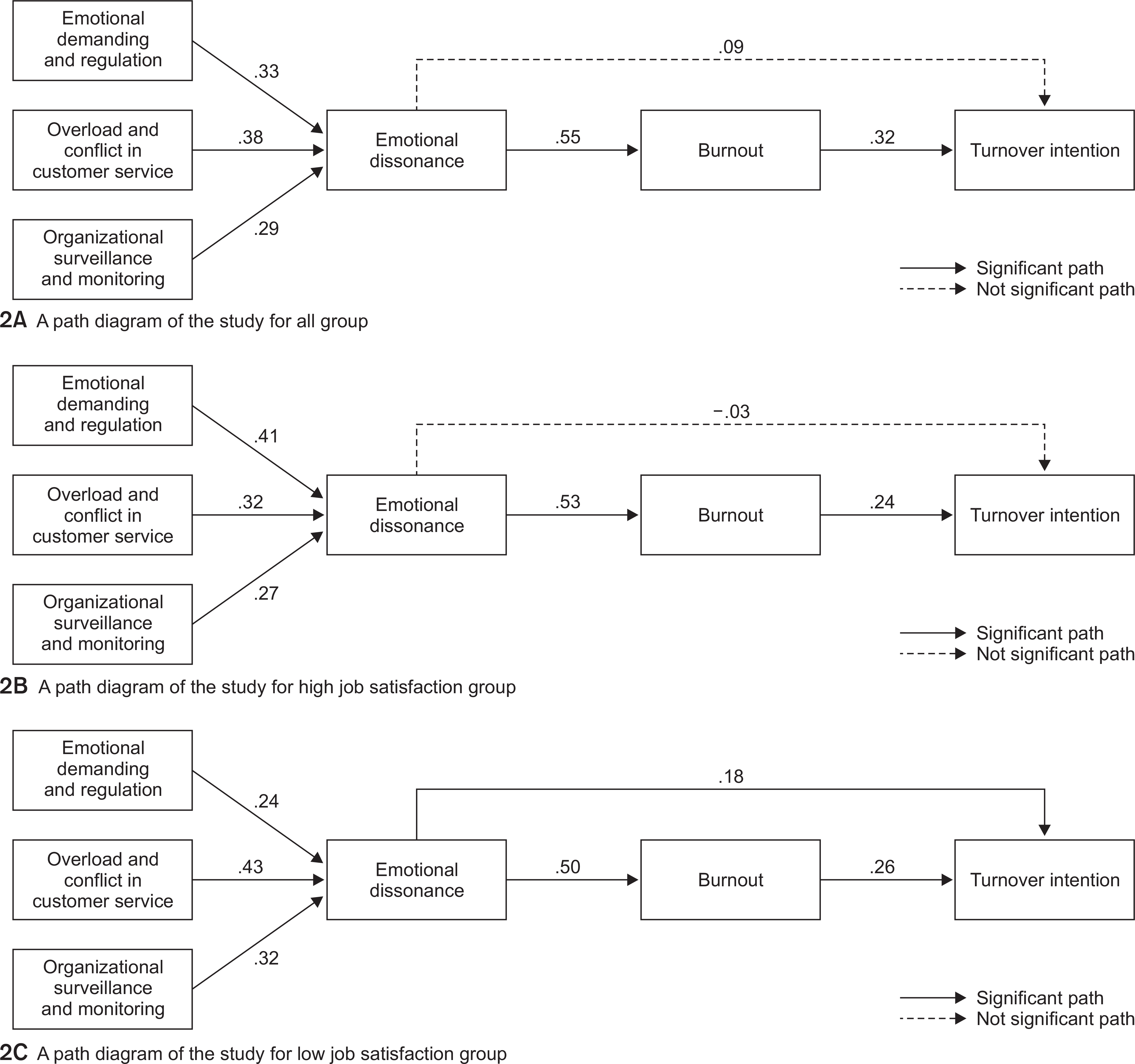Abstract
Purpose
This study was conducted to investigate the influence of emotional labor, emotional dissonance, and burnout on nurse's turnover intention and examine the effect of job satisfaction on the relationships among emotional labor, emotional dissonance, burnout, and turnover intention.
Methods
The sample consisted of 350 nurses recruited from 6 general hospitals in 2 cities in Korea. A multiple-group analysis was utilized. Data were analyzed using SPSS statistics 23 and AMOS 20.
Results
In the path analysis, turnover intention was directly related to burnout in clinical nurses who had a high job satisfaction (b=.24, p=.003), while it was indirectly related to emotional dissonance (b=.13, p=.002). In the multiple-group path analysis, turnover intention was directly related to emotional dissonance (b=.18, p=.033) and burnout (b=.26, p=.002) for nurses with low job satisfaction.
Conclusion
These results indicate that manuals and guidelines to alleviate the negative effects of emotional labor, emotional dissonance, and burnout, and to increase job satisfaction are strongly required to reduce turnover intention in nurses at the organizational level as well as at the individual level.
References
1. Global Health Workforce Alliance. Global health workforce crisis: Key message [Internet]. Geneva: WHO;c2014. [cited 2017 Aug 15]. Available from:. http://www.who.int/workforcealliance/en/.
2. Hospital Nurses Association. Man power loading chart of hospital. Annual report of hospital nurses association [Internet]. Seoul: Hospital Nurses Association;c2016. [cited 2017 Aug 15]. Available from:. http://www.khna.or.kr/web/information/resource.php.
3. Nursing Solutions Inc. 2017 National healthcare care retention & RN staffing report [Internet]. East Petersburg (PA): Nursing Solutions Inc.;c2017. [cited 2017 Aug 15]. Available from:. http://www.nsinursingsolutions.com/.
4. Health Education England. Growing nursing numbers: Literature review on nurses leaving the NHS [Internet]. UK: NHS;c2014. [cited 2017 Aug 15]. Available from:. http://hee.nhs.uk/work-programmes/nurse-return-to-practice.
5. Jourdain G, Chênevert D. Job demands-resources, burnout and intention to leave the nursing profession: A questionnaire survey. International Journal of Nursing Studies. 2010; 47(6):709–722. https://doi.org/10.1016/j.ijnurstu.2009.11.007.

6. Flinkman M, Leino-Kilpi H, Salanterä S. Nurses’ intention to leave the profession: Integrative review. Journal of Advanced Nursing. 2010; 66(7):1422–1434. https://doi.org/10.1111/j.1365-2648.2010.05322.x.

7. Kim JK, Kim MJ. A review of research on hospital nurses’ turnover intention. Journal of Korean Academy of Nursing Administration. 2011; 17(4):538–550. https://doi.org/10.11111/jkana.2011.17.4.538.

8. Grandey A, Diefendorff J, Rupp DE. Emotional labor in the 21st century: Diverse perspectives on emotion regulation at work. New York (NY): Routledge;2013. p. 3–27.
9. Hochschild AR. The managed heart: Commercialization of human feeling. Berkeley (CA): University of California;1983. p. 89–136.
10. Bakker AB, Heuven E. Emotional dissonance, burnout, and in-role performance among nurses and police officers. International Journal of Stress Management. 2006; 13(4):423–440. https://doi.org/10.1037/1072-5245.13.4.423.

11. Lee H, Cummings GG. Factors influencing job satisfaction of front line nurse managers: A systematic review. Journal of Nursing Management. 2008; 16(7):768–783. https://doi.org/10.1111/j.1365-2834.2008.00879.x.

12. Kim YS. Nurses job stress influencing on the burnout and turnover intentions [master’s thesis]. Seoul: Kyung Hee University;2011. p. 1–70.
13. Ashforth BE, Humphrey RH. Emotion in the workplace: A reappraisal. Human Relations. 1995; 48(2):97–125. https://doi.org/10.1177/001872679504800201.

14. Morris JA, Feldman DC. The dimensions, antecedents, and consequences of emotional labor. Academy of Management Review. 1996; 21(4):986–1010. https://doi.org/10.5465/AMR.1996.9704071861.

15. van Gelderen BR, Bakker AB, Konijn EA, Demerouti E. Daily suppression of discrete emotions during the work of police service workers and criminal investigation officers. Anxiety, Stress, & Coping. 2011; 24(5):515–537. https://doi.org/10.1080/10615806.2011.560665.

16. Heuven E, Bakker A. Emotional dissonance and burnout among cabin attendants. European Journal of Work and Organizational Psychology. 2003; 12(1):81–100. https://doi.org/10.1080/13594320344000039.

17. Franco M, Trombetta M. Cybernetic theory as a new approach to studying workers’well-being. Croatian Economic Survey. 2010; 12(1):163–198.
18. Maslach C, Jackson SE. The measurement of experienced burnout. Journal of Organizational Behavior. 1981; 2(2):99–113. https://doi.org/10.1002/job.4030020205.

19. Güleryüz G, Güney S, Aydin EM, Aşan O. The mediating effect of job satisfaction between emotional intelligence and organisational commitment of nurses: A questionnaire survey. International Journal of Nursing Studies. 2008; 45(11):1625–1635. https://doi.org/10.1016/j.ijnurstu.2008.02.004.

20. Bakker AB, Demerouti E. The job demands-resources model: State of the art. Journal of Managerial Psychology. 2007; 22(3):309–328. https://doi.org/10.1108/02683940710733115.

21. Mobley WH. Employee turnover, causes, consequences, and control. Reading (MA): Addison-Wesley;1982. p. 88–102.
22. Niven K, Totterdell P, Holman D, Cameron D. Emotional labor at the unit-level. Grandey A, Diefendorff J, Rupp DE, editors. Emotional Labor in the 21st Century: Diverse Perspectives on Emotion Regulation at Work. New York (NY): Routledge;2013. p. 101–124.
23. Lee HY. Research methodology. 2nd ed. Seoul: Cheongram;2012. p. 531–556.
24. Chang SJ, Kang HT, Kim SY, Kim IA, Kim JI, Kim HY, et al. The development of Korean emotional labor scale and Korean violence scale 2013. Seoul: The Korea Occupational Safety and Health Agency;2014. p. 70–73.
25. Choi HY. Perfectionism tendency, social support, and burnout among counselors [master’s thesis]. Seoul: The Catholic University of Korea;2002. p. 1–96.
26. Pejtersen JH, Kristensen TS, Borg V, Bjorner JB. The second version of the Copenhagen Psychosocial Questionnaire. Scandinavian Journal of Public Health. 2010; 38(3 Suppl):8–24. https://doi.org/10.1177/1403494809349858.

27. Park IS. The relationships among nursing workload, nurse manager’s social support, nurses’psychosocial health and job satisfaction [dissertation]. Seoul: Seoul National University;2016. p. 1–112.
28. Lee HS, Lim JH. Structural equation modeling with AMOS 24. Seoul: Jyphyunjse;2017. p. 253–266.
29. Andela M, Truchot D. Emotional dissonance and burnout: The moderating role of team reflexivity and re-evaluation. Stress and Health. 2017; 33(3):179–189. https://doi.org/10.1002/smi.2695.

Table 1.
Difference in Emotional Labor, Emotionnal Dissonance, Burnout and Turnover Intenttion Based on Job Satisfaction (N=350)
Table 2.
Results of Differences Between Endogenous Variables and Exogenous Variables in the Two Models
Table 3.
Standardized Estimates, Critical Ratio, Squared Multiple Correlation, Standardized Direct, Indirect, and Total Effect for Modified Model




 PDF
PDF ePub
ePub Citation
Citation Print
Print




 XML Download
XML Download